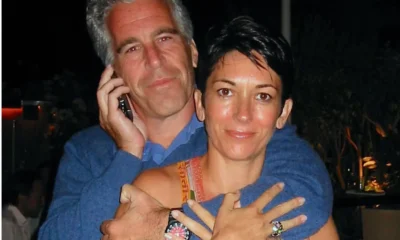Entertainment
Tammy Slaton Lays Husband to Rest on 1000-Lb Sisters Season Finale, Cries and Cries on February 4, 2024 at 1:17 pm The Hollywood Gossip
Tammy Slaton will not be able to keep it together on the upcoming season finale of 1000-Lb Sisters.
For the most tragic and understandable of reasons.
To close out an emotional run of episodes, this TLC reality series will feature the funeral service for Caleb Willingham on February 6… as Tammy’s husband passed this June at the very young age of 40.
The finale in question was filmed very shortly afterward.
Tammy Slaton cries here over the death of husband Caleb Willingham. (TLC)
“Tammy, how are you doing today baby?” brother Chris asks her while they drive to the memorial in a sneak peek published by People Magazine.
“I’m having my ups and downs, I guess,” Tammy replies while crying.
“It hurt when Grandma died, but this is a different kind of hurt….it sure is a pretty day though.”
Amy Slaton later gives an update on her grieving sibling.
“Tammy’s numb right now,” the co-star explains to the camera.
“She doesn’t know how to feel. She doesn’t know how to process grief like a normal human being. We were told to push our feelings down, not to embrace them. So, she’s just trying to manage the way she can.”
Tammy Slaton receives comfort at her husband’s memorial service. (TLC)
No cause of death was ever announced for Willingham.
However, he remained in the Ohio rehab facility where he and Tammy had met because, unlike his wife, Caleb continued to struggle with his weight.
On one episode earlier this season, Slaton warned Willingham that his food addiction may prove to be deadly.
It was eerie and heart-breaking to witness all this time later.
Tammy Slaton is visiting the doctor in this scene from 1000-Lb Sisters. (TLC)
After arriving at the memorial, meanwhile, the family meet up on the finale their friend Billy, a home care nurse who also officiated Tammy’s wedding.
“Nine months ago, Tammy asked me to officiate her wedding,” Billy says on air.
“It’s really hard to put into words how to go from one extreme of officiating a wedding and just watching Tammy in the happiest points of her life just to turn around and in less than a year I have to witness her in the most tragic time of her life.”
Seriously.
Just so, so, so sad.
Tammy Slaton in front of the cameras here on 1000-Lb Sisters Season 5. (TLC)
Caleb proposed in October 2022 and the pair got married a month later in the parking lot of the aforementioned rehab center.
“When I met Caleb he became my guardian angel and now he really is watching over me,” Tammy said after losing her spouse, describing herself as “devastated.”
“Our families appreciate everyone’s sympathy and ask that you respect our privacy at this time.”
After news broke of Willingham’s death, TLC released the following statement:
“We are deeply saddened to learn of Caleb Willingham’s passing. Our condolences go out to Tammy, his family and friends at this difficult time.”
The season finale of 1000-Lb. Sisters airs Tuesday, February 6 at 9/8c.
Tammy Slaton Lays Husband to Rest on 1000-Lb Sisters Season Finale, Cries and Cries was originally published on The Hollywood Gossip.
[[{“value”:”Tammy Slaton will break down in tears on the final episode of 1000-Lb Sisters. For the saddest and most understandable of reasons.
Tammy Slaton Lays Husband to Rest on 1000-Lb Sisters Season Finale, Cries and Cries was originally published on The Hollywood Gossip.”}]]
The Hollywood Gossip Read More
Entertainment
What We Can Learn Inside 50 Cent’s Explosive Diddy Documentary: 5 Reasons You Should Watch

50 Cent’s new Netflix docuseries about Sean “Diddy” Combs is more than a headline-grabbing exposé; it is a meticulous breakdown of how power, celebrity, and silence can collide in the entertainment industry.
Across its episodes, the series traces Diddy’s rise, the allegations that followed him for years, and the shocking footage and testimonies now forcing a wider cultural reckoning.

1. It Chronicles Diddy’s Rise and Fall – And How Power Warps Reality
The docuseries follows Combs from hitmaker and business icon to a figure facing serious criminal conviction and public disgrace, mapping out decades of influence, branding, and behind-the-scenes behavior. Watching that arc shows how money, fame, and industry relationships can shield someone from scrutiny and delay accountability, even as disturbing accusations accumulate.

2. Never-Before-Seen Footage Shows How Narratives Are Managed
Exclusive footage of Diddy in private settings and in the tense days around his legal troubles reveals how carefully celebrity narratives are shaped, even in crisis.
Viewers can learn to question polished statements and recognize that what looks spontaneous in public is often the result of strategy, damage control, and legal calculation.
3. Survivors’ Stories Highlight Patterns of Abuse and Silence
Interviews with alleged victims, former staff, and industry insiders describe patterns of control, fear, and emotional or physical harm that were long whispered about but rarely aired in this detail. Their stories underline how difficult it is to speak out against a powerful figure, teaching viewers why many survivors delay disclosure and why consistent patterns across multiple accounts matter.
4. 50 Cent’s Approach Shows Storytelling as a Tool for Accountability
As executive producer, 50 Cent uses his reputation and platform to push a project that leans into uncomfortable truths rather than protecting industry relationships. The series demonstrates how documentary storytelling can challenge established power structures, elevate marginalized voices, and pressure institutions to respond when traditional systems have failed.
5. The Cultural Backlash Reveals How Society Handles Celebrity Accountability
Reactions to the doc—ranging from people calling it necessary and brave to others dismissing it as a vendetta or smear campaign—expose how emotionally invested audiences can be in defending or condemning a famous figure. Watching that debate unfold helps viewers see how fandom, nostalgia, and bias influence who is believed, and why conversations about “cancel culture” often mask deeper questions about justice and who is considered too powerful to fall.
Entertainment
South Park’s Christmas Episode Delivers the Antichrist

A new Christmas-themed episode of South Park is scheduled to air with a central plot in which Satan is depicted as preparing for the birth of an Antichrist figure. The premise extends a season-long narrative arc that has involved Satan, Donald Trump, and apocalyptic rhetoric, positioning this holiday episode as a culmination of those storylines rather than a stand‑alone concept.
Episode premise and season context
According to published synopses and entertainment coverage, the episode frames the Antichrist as part of a fictional storyline that blends religious symbolism with commentary on politics, media, and cultural fear. This follows earlier Season 28 episodes that introduced ideas about Trump fathering an Antichrist child and tech billionaire Peter Thiel obsessing over prophecy and end‑times narratives. The Christmas setting is presented as a contrast to the darker themes, reflecting the series’ pattern of pairing holiday imagery with controversial subject matter.
Public and political reactions
Coverage notes that some figures connected to Donald Trump’s political orbit have criticized the season’s portrayal of Trump and his allies, describing the show as relying on shock tactics rather than substantive critique. Commentators highlight that these objections are directed more at the depiction of real political figures and the show’s tone than at the specific theology of the Antichrist storyline.
At the time of reporting, there have not been widely reported, detailed statements from major religious leaders focused solely on this Christmas episode, though religion-focused criticism of South Park in general has a long history.
Media and cultural commentary
Entertainment outlets such as The Hollywood Reporter, Entertainment Weekly, Forbes, Slate, and USA Today describe the Antichrist arc as part of South Park’s ongoing use of Trump-era and tech-world politics as material for satire.
Viewer guidance and content advisory
South Park is rated TV‑MA and is intended for adult audiences due to strong language, explicit themes, and frequent use of religious and political satire. Viewers who are sensitive to depictions of Satan, the Antichrist, or parodies involving real political figures may find this episode particularly objectionable, while others may view it as consistent with the show’s long‑running approach to controversial topics. As with previous episodes, individual responses are likely to vary widely, and the episode is best understood as part of an ongoing satirical series rather than a factual or theological statement.
Entertainment
Sydney Sweeney Finally Confronts the Plastic Surgery Rumors

Sydney Sweeney has decided she is finished watching strangers on the internet treat her face like a forensic project. After years of side‑by‑side screenshots, “then vs now” TikToks, and long comment threads wondering what work she has supposedly had done, the actor is now addressing the plastic surgery rumors directly—and using them to say something larger about how women are looked at in Hollywood and online.

Growing Up on Camera vs. “Before and After” Culture
Sweeney points out that people are often mistaking normal changes for procedures: she grew up on camera, her roles now come with big‑budget glam teams, and her body has shifted as she has trained, aged, and worked nonstop. Yet every new red‑carpet photo gets folded into a narrative that assumes surgeons, not time, are responsible. Rather than walking through a checklist of what is “real,” she emphasizes how bizarre it is that internet detectives comb through pores, noses, and jawlines as if they are owed an explanation for every contour of a woman’s face.
The Real Problem Isn’t Her Face
By speaking up, Sweeney is redirecting the conversation away from her features and toward the culture that obsesses over them.
She argues that the real issue isn’t whether an actress has had work done, but why audiences feel so entitled to dissect her body as public property in the first place.
For her, the constant speculation is less about curiosity and more about control—another way to tell women what they should look like and punish them when they do not fit. In calling out that dynamic, Sweeney isn’t just defending herself; she is forcing fans and followers to ask why tearing apart someone else’s appearance has become such a popular form of entertainment.

 Entertainment2 weeks ago
Entertainment2 weeks agoWicked Sequel Disappoints Fans: Audience Verdict on For Good

 News4 weeks ago
News4 weeks agoYolanda Adams Questions Traditional Views on God’s Gender, Audience Reacts

 Entertainment2 weeks ago
Entertainment2 weeks agoAriana & Cynthia Say They’re in a ‘Non‑Demi Curious, Semi‑Binary’ Relationship… WTF Does That Even Mean?

 News3 weeks ago
News3 weeks agoEpstein Files to Be Declassified After Trump Order

 News4 weeks ago
News4 weeks agoTrump Throws Epstein Files at Clinton’s Door

 Entertainment4 weeks ago
Entertainment4 weeks agoAriana Grande’s Red Carpet: When Fans Forget Boundaries

 Entertainment4 weeks ago
Entertainment4 weeks agoHollywood’s Kiss or Miss Policy: Why Saying No Got Neal McDonough Blackballed

 Entertainment3 weeks ago
Entertainment3 weeks agoJimmy Cliff, Reggae Legend and Star of ‘The Harder They Come,’ Dies at 81


























